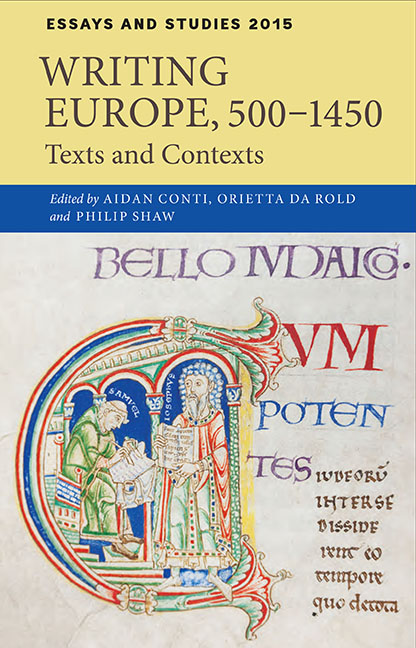Book contents
- Frontmatter
- Contents
- List of Illustrations
- Notes on Contributors
- Preface
- Acknowledgments
- List of Abbreviations
- Medieval Manuscript Studies: A European Perspective
- The DigiPal Project for European Scripts and Decorations
- Italian Giant Bibles: The Circulation and Use of the Book at the Time of the Ecclesiastical Reform in the Eleventh and Twelfth Centuries
- Isolation or Network: Arengas and Colophon Verse in Frisian Manuscripts around 1300
- Writing the Germanic Languages: The Early History of the Digraphs
, and The New Heathens: Anti-Jewish Hostility in Early English LiteratureLatin Composition in Medieval NorwayTranslating Europe in Medieval WalesCharms among the Chants: Verbal Magic in Medieval Bulgarian ManuscriptsIndexLatin Composition in Medieval Norway
Published online by Cambridge University Press: 11 June 2021
ByBook contents- Frontmatter
- Contents
- List of Illustrations
- Notes on Contributors
- Preface
- Acknowledgments
- List of Abbreviations
- Medieval Manuscript Studies: A European Perspective
- The DigiPal Project for European Scripts and Decorations
- Italian Giant Bibles: The Circulation and Use of the Book at the Time of the Ecclesiastical Reform in the Eleventh and Twelfth Centuries
- Isolation or Network: Arengas and Colophon Verse in Frisian Manuscripts around 1300
- Writing the Germanic Languages: The Early History of the Digraphs , and
- The New Heathens: Anti-Jewish Hostility in Early English Literature
- Latin Composition in Medieval Norway
- Translating Europe in Medieval Wales
- Charms among the Chants: Verbal Magic in Medieval Bulgarian Manuscripts
- Index
Summary
IN THE PAST DECADE, the study of Latin writing in Scandinavia has enjoyed a resurgence. Lavishly illustrated collections of papers have examined the Latin manuscript culture for both Sweden and Norway. Based on the cataloguing of the fragments of the National Library of Finland, an account of Latin in Finland (then eastern Sweden) has been produced. The dictionary of medieval Latin covering Sweden has been completed, and that for Denmark is nearly complete. In the field of literary history, the late Karsten Friis-Jensen has surveyed the production of Latin works in Scandinavia; Gottskálk Jensson has reclaimed the place of Latin learning within the literary landscape of Iceland in particular. The entire region has an electronic handbook that covers known literary works from before the Reformation. This body of work has had a salutary effect on rehabilitating an area of study often overlooked, the international dimensions of which have often been passed over in favour of more narrowly defined national material from the Middle Ages. As a result of this perceived absence, in the popular imagination the culture of Latin learning, and often relatedly the thoroughness of Christianisation, has been seen as minimal and perhaps not as consequential as in other parts of Europe. The present piece will offer an overview of the corpus of Latin composed in Norway in the Middle Ages and consider this production as part of a larger landscape of Latin learning to suggest a holistic view of Latin in Norway. Recent work on the manuscript culture of Norway has been particularly instrumental in redressing our understanding of Latin writing in Norway; the destruction of Latin material during the Lutheran Reformation effectively erased from consideration the range of Latin material that had been reproduced, transmitted and circulated in the north during the medieval period. Moreover, increasing evidence from inscribed material promises to inform further our understanding of popular Latin literacy. A consideration of the literary production of Latin composed in the country offers something of a counter-balance to the perspective.
The parameters of the corpus of medieval Latin from Norway – what it comprises and its limits – is very much a story of efforts to assemble a dictionary of Norwegian medieval Latin. In the 1940s material began to be compiled and excerpted under the direction of Eirik Vandvik at the University of Oslo.
- Type
- Chapter
- Information
- Writing Europe, 500-1450Texts and Contexts, pp. 147 - 158Publisher: Boydell & BrewerPrint publication year: 2015
- 1
- Cited by
Save book to Kindle
To save this book to your Kindle, first ensure no-reply@cambridge.org is added to your Approved Personal Document E-mail List under your Personal Document Settings on the Manage Your Content and Devices page of your Amazon account. Then enter the ‘name’ part of your Kindle email address below. Find out more about saving to your Kindle.
Note you can select to save to either the @free.kindle.com or @kindle.com variations. ‘@free.kindle.com’ emails are free but can only be saved to your device when it is connected to wi-fi. ‘@kindle.com’ emails can be delivered even when you are not connected to wi-fi, but note that service fees apply.
Find out more about the Kindle Personal Document Service.
- Latin Composition in Medieval Norway
-
- Book: Writing Europe, 500-1450
- Online publication: 11 June 2021
×Save book to Dropbox
To save content items to your account, please confirm that you agree to abide by our usage policies. If this is the first time you use this feature, you will be asked to authorise Cambridge Core to connect with your account. Find out more about saving content to Dropbox.
- Latin Composition in Medieval Norway
-
- Book: Writing Europe, 500-1450
- Online publication: 11 June 2021
×Save book to Google Drive
To save content items to your account, please confirm that you agree to abide by our usage policies. If this is the first time you use this feature, you will be asked to authorise Cambridge Core to connect with your account. Find out more about saving content to Google Drive.
- Latin Composition in Medieval Norway
-
- Book: Writing Europe, 500-1450
- Online publication: 11 June 2021
×

